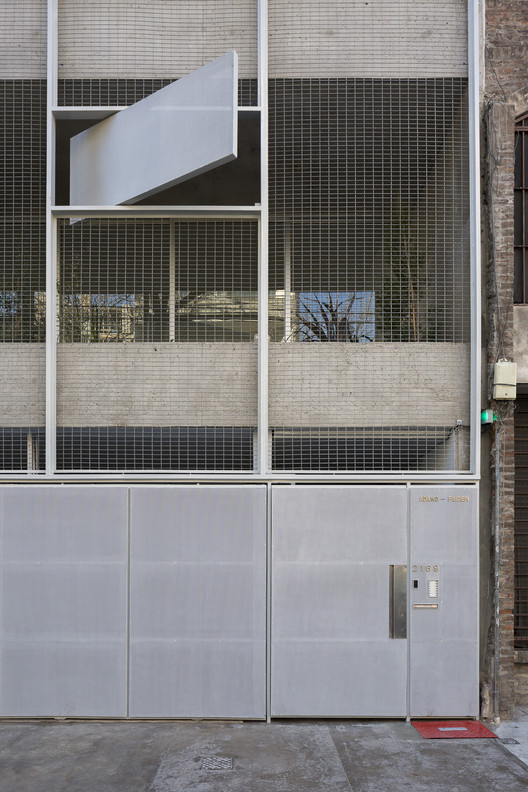Transparent Solutions Tóth Project Architect Office
2017-06-13 05:00
架构师提供的文本描述。直到20世纪初,首都布达佩斯一侧(布达佩斯)的山坡,也就是名为布达的地区的山坡,以前都是用藤蔓排列的。从本世纪下半叶开始,葡萄种植开始衰落,葡萄藤行被小块地取代,周末地产在那里激增,从上世纪90年代起,在那里建造了越来越多的独立房屋。前葡萄园唯一的提醒是典型的“带状”地块:狭长的地块通常被分成两部分,一块靠近街道的上部划出地块,另一部分在地块后面。
Text description provided by the architects. Until the early 20th century, the slopes of the Buda side of the capital (Budapest), that is, the hillside of the area called Óbuda used to be lined by vine rows. From the second half of the century on, viticulture started to wane and the vine rows were replaced by small plots and weekend properties proliferating there and, from the 1990s on, a growing number of detached houses were built there. The only reminder of the former vineyards is the typical “belt-shaped” plots: the narrow, long plots have often been divided into two, an upper part next to the street delimiting the plot and a lower one back in the plot.
© Tamás Bujnovszky
c.Tamás Bujnovszky


这个两层楼(一楼和一楼)独立的房子是在2299平方米的较低的地块上建造的,与街道相连的是一个狭长的地块延伸部分(人行道)。它的设计起点是地块的坡度。因此,沿着人行道走到入口处的街道上,人们可以看到一栋一层楼高的建筑,但由于地形的高度,房子逐渐变成了两层楼。
This two-storey (ground floor and first floor) detached house was built on one of this lower plots of 2299 m2, connected to the street by a panhandle-like plot extension (a sidewalk). The starting point of its design was the slope of the plot. Therefore, walking down from the street along the sidewalk to the entrance of the house, one sees a one-storey building, but given the elevation of the terrain, the house gradually becomes a two-storey one.
© Tamás Bujnovszky
c.Tamás Bujnovszky


Ground Floor Plan


© Tamás Bujnovszky
c.Tamás Bujnovszky


First Floor Plan
一层平面图
.jpg)

当你绕着大楼走的时候,两层楼的形式逐渐出现了.随着形式的披露,房子向花园敞开:相对于一层楼,更封闭的入口部分,在花园的一侧,房子正透过一个基本均匀、透明的玻璃滑动门,看到花园的景观。房子的外观优雅,有约束;它是由带有横向和纵向支撑单元的钢筋混凝土单层板系统和由砌块构成的承重墙组成的。
As you go round the building, the two-storey form gradually appears. As the form is being disclosed, the house opens up to the garden: opposite to the one-storey, more closed entrance part, on the side of the garden, the house is looking at the garden, the landscape through a basically homogeneous, transparent glazed facade with glass sliding doors. The external appearance of the house is elegant, restrained; it was made with a monolith reinforced concrete slab system with transversal and longitudinal support elements, and load-bearing walls made of building blocks.
© Tamás Bujnovszky
c.Tamás Bujnovszky


典雅、节制的用材也是典型的室内空间。后者只配备最必要的家具,因此室内空间宽敞、通风。底层的社区空间和一楼的私人空间通过几种室内设计方案相互联系:除了卧室和衣柜中的地板覆盖物外,所有地方都采用相同的无连接装饰石板,砌体部分是均匀白色的;楼梯是一座通往一楼的钢结构,由单层钢筋混凝土制成,采用悬臂式设计,使其几乎浮在空中,溶于空间。
Elegance, the restrained use of materials is typical also in the interior spaces. The latter are furnished with only the most necessary pieces of furniture, so the interiors are spacious and airy. The community spaces on the ground floor and the private ones on the first floor are interlinked by several interior design solutions: except for the parquet floor coverings in the sleeping rooms and the wardrobes, the same jointless decorative stone cladding is applied everywhere, and the masonry parts are uniformly white; the flight of stairs, a steel structure leading to the first floor, made of monolith reinforced concrete, has a cantilevered design that makes it almost float, dissolve in space.
© Tamás Bujnovszky
c.Tamás Bujnovszky


从入口处已经可以看到地面总面积,因为各种功能单元(厨房、餐厅、客厅、办公室、楼梯)都是用玻璃墙和滑动玻璃门划定的。此外,这座房子还具有建筑和室内设计的特点:在各功能单元的交汇处,一楼有一个特殊的玻璃立方体,向屋顶开放,里面有一棵百年至一百五十岁的橄榄树。
The total ground floor area can be seen already from the entrance, since the various functional units (kitchen, dining room, living room, office, staircase) are delimited by glass walls and sliding glass doors. Moreover, the house features an architectural and at the same time interior design feat: at the meeting point of the various functional units, there is a special glass cube on the first floor, opening up towards the roof area, with a magnificent 100-150-year-old olive tree inside.
© Tamás Bujnovszky
c.Tamás Bujnovszky






















































.jpg)









Architects Tóth Project Architect Office
Location Budapest, Hungary
Category Houses
Architects in Charge László Tóth, László Papp, Frigyes Schalling, Péter Schmidt
Area 451.0 m2
Project Year 2016
Photographs Tamás Bujnovszky
























